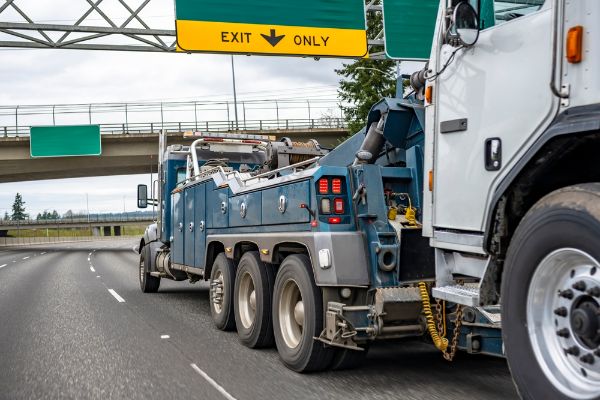In today’s fast-paced world, heavy duty towing emergencies can arise unexpectedly. Whether you’re managing a fleet or driving a large vehicle, knowing how to handle these situations effectively is crucial. This comprehensive guide aims to equip you with the essential knowledge and steps necessary to manage a heavy duty towing emergency with confidence and efficiency.

Understanding Heavy Duty Towing
Heavy duty towing refers to the process of moving large vehicles, such as buses, trucks, or construction equipment, that are too heavy for standard towing services. These situations require specialized equipment and trained professionals who understand the unique challenges involved in towing oversized vehicles.
Types of Heavy Duty Towing Situations
Heavy duty towing emergencies can occur due to a variety of reasons:
- Accidents: Collisions involving large vehicles can result in significant damage and require towing services.
- Mechanical Failures: Engine failures, flat tires, or other mechanical issues can render a heavy vehicle inoperable.
- Inclement Weather: Adverse weather conditions can lead to accidents or breakdowns, necessitating towing.
- Vehicle Overload: Overloading a vehicle can lead to breakdowns or accidents, making towing necessary.
Immediate Steps to Take in an Emergency
Assess the Situation
Upon realizing you are in a heavy duty towing emergency, the first step is to assess the situation. Check for:
- Safety: Ensure you and any passengers are safe. If possible, move the vehicle to a secure location away from traffic.
- Injuries: Check for any injuries among passengers or others involved. Call emergency services if necessary.
- Environment: Evaluate the surrounding environment, including road conditions, weather, and traffic flow.
Notify the Authorities
In many cases, especially those involving accidents, it is essential to notify law enforcement. This step not only ensures safety but also provides an official record of the incident, which can be useful for insurance claims.
Contact a Professional Towing Service
After ensuring safety and notifying the authorities, the next crucial step is to contact a professional heavy duty towing service. When choosing a towing service, consider the following:
- Experience: Ensure the towing company has experience with heavy duty vehicles.
- Equipment: Inquire about the type of equipment they use for towing heavy vehicles.
- Response Time: A reliable service should be able to respond quickly to your location.
- Insurance and Licensing: Verify that the towing company is insured and licensed to operate in your area.
What to Expect from a Heavy Duty Towing Service
When the towing service arrives, they will take the following steps to manage the situation:
Evaluation and Preparation
The towing professionals will evaluate the condition of the vehicle and the surrounding area. They will:
- Inspect the Damage: Check for any visible damage to the vehicle and surrounding property.
- Determine the Best Towing Method: Choose the most appropriate towing method based on the vehicle type and damage extent.
Utilizing Specialized Equipment
Heavy duty towing requires specialized equipment, which may include:
- Heavy Duty Tow Trucks: These trucks are designed to handle the weight and size of large vehicles.
- Winches and Slings: Used to secure and lift the vehicle for safe transport.
- Flatbed Trailers: For transporting vehicles without driving them onto the truck.
Secure Loading Procedures
Proper loading is crucial to prevent further damage during transport. Towing professionals will:
- Secure the Vehicle: Use straps and chains to secure the vehicle on the tow truck.
- Check Weight Distribution: Ensure the weight is evenly distributed to maintain stability during transport.
Post-Towing Steps
Once the vehicle is safely loaded and en route, the next steps involve:
Contacting Your Insurance Provider
Notify your insurance company about the incident. Provide them with all necessary details, including:
- Incident Report: Any reports filed by law enforcement.
- Towing Details: Information about the towing service used and the vehicle condition.
Arranging for Repairs
After the vehicle is towed to a designated location, it’s time to arrange for repairs. This process may include:
- Assessment by a Mechanic: Have a qualified mechanic evaluate the vehicle’s condition.
- Estimate Repairs: Obtain an estimate for necessary repairs to understand the costs involved.
Preventative Measures for the Future
To minimize the chances of future heavy duty towing emergencies, consider implementing the following:
- Regular Maintenance: Ensure your vehicles are regularly serviced to prevent mechanical failures.
- Driver Training: Provide training for drivers on how to handle potential emergencies.
- Emergency Kits: Equip vehicles with emergency kits that include safety gear, tools, and contact information for towing services.
Conclusion
Handling a heavy duty towing emergency requires a combination of quick thinking, knowledge, and reliance on professional services. By following the steps outlined in this guide, you can navigate these challenging situations with confidence. Always prioritize safety, communicate effectively, and stay informed about the best practices in heavy duty towing. read more…





Leave a comment
Your email address will not be published. Required fields are marked *